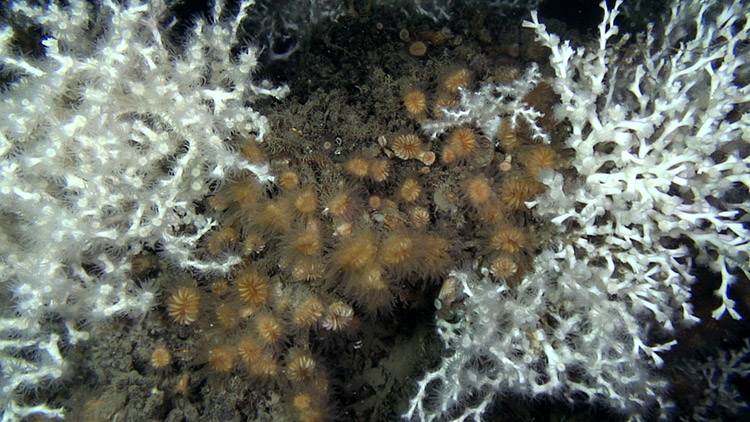Acting Student and Bioengineering Alumna Awarded Soros Fellowship for New Americans
Awards & Accolades

Cold-water coral reefs vulnerable to warming and acidification in Mediterranean canyons. Photo courtesy of N. Le Bris, Laboratoire d'Ecogéochimie des Environnements Benthiques (LECOB), Fondation Total–UPMC.
In largely unseen ways, humans are changing the character of the deep oceans, disrupting environmental conditions and threatening biodiversity to an extent that could require hundreds of years or more for natural systems to recover.
Now in a new paper appearing in a special edition of the journal Science, Scripps Institution of Oceanography at UC San Diego biological oceanographer Lisa Levin and marine ecologist Nadine Le Bris of University Pierre and Marie Curie, from a joint research lab of France’s Centre National de la Recherche Scientifique, argue that international climate negotiations should include mitigation and adaptation mechanisms that support healthy oceans through protections of deep waters.
The deep oceans, defined as ocean depths below 200 meters (650 feet), make up most of the habitable space on Earth. They have served as a buffer against damaging consequences of human-caused climate change by absorbing the carbon dioxide produced by fossil fuel burning and the excess heat that the greenhouse gas adds to Earth systems. The protection has come at a cost, however, as there is evidence that as the ocean becomes warmer, expanses of deep ocean have also experienced reductions in pH and oxygen content.
The effects caused by climate change add to other stresses to deep-ocean ecosystems caused by oil exploration, the accumulation of garbage and hazardous chemicals, and the practice of seafloor trawling by fishing fleets. Seafloor mining would exacerbate the stress.
The climate talks hosted by the United Nations Framework Convention on Climate Change are known as the 21st Conference of the Parties or COP21. Countries participating in the talks are expected to agree to self-imposed mitigation efforts that reduce CO2 emissions, and range from increased use of renewable energy to protection of forests. Many countries will additionally pledge to step up research and improve their ability to observe natural systems.
At present, 64 percent of oceans are beyond national jurisdictions and coordinated international management of climate and its impacts in the deep sea is virtually nonexistent. Because of their role in regulating climate, the deep- ocean’s ecosystems require a protection mechanism, the authors argue. An important first step to establish that protection is to improve understanding of the deep oceans, which scientists have noted remain even less explored than some other planets.
“Explicit recognition of deep-ocean climate mitigation and inclusion in adaptation planning by the United Nations Framework Convention on Climate Change (UNFCCC) could help to expand deep-ocean research and observation and to protect the integrity and functions of deep-ocean ecosystems,” the authors write.
The article, “The deep ocean under climate change,” appears in a special issue of the journal Science devoted to ocean climate change that is being published Nov. 13 ahead of the COP21 talks, which take place over two weeks in early December.
Levin and Le Bris note that there are very few comprehensive studies of climate change impacts on life in the deep oceans over modern time scales. However, existing observations reveal a wide range of habitats in the deep ocean ranging from hydrothermal vent and seep communities, to deep canyons and seamounts.“There are also vast abyssal habitats beneath low-nutrient (oligotrophic) waters. In these habitats, time almost stands still; potato-size manganese nodules form over millions of years, organisms grow slowly, and full recovery from human disturbances might require centuries or more,” the authors write.
Despite being somewhat removed from life on Earth’s surface, these systems are sensitive to climate-introduced changes that reach the deep via ocean circulation.
Temperature-induced crab invasions in Antarctica, acidification damage to corals, and expanding hypoxia in upwelling systems are some of the manifestations. If these systems are damaged, their ability to protect the rest of the planet could be compromised for years.
Levin hopes the paper will stimulate thinking about the ocean, in particular the importance of expanding deep-ocean observation systems and making protection of the deep ocean, a very large and pivotal part of the global commons, priorities that will be discussed beyond COP21. Diminishing fossil fuel use will help maintain the integrity of the deep ocean, but limiting damage will also require actions such as creation of a network of marine protected areas in the deep, that restrict other forms of human disturbance.
Keep up with all the latest from UC San Diego. Subscribe to the newsletter today.